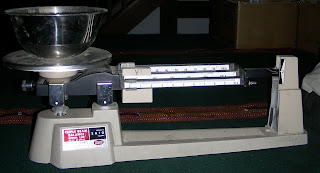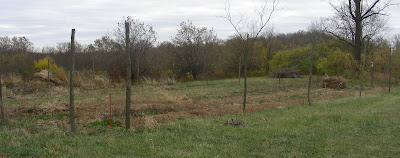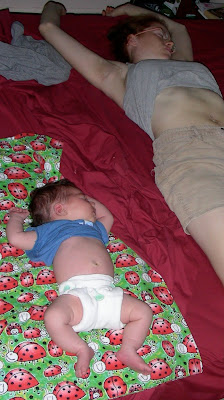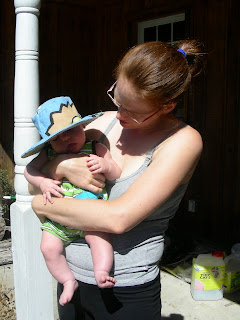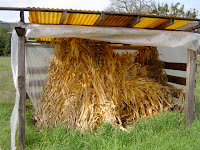We have this classy old Ford 2000 tractor that does all of our big mowing and pulling around of heavy things. To look at a clean one you can click
here. It's a small tractor, easy to use, and has the bare minimum of parts. When something goes wrong, then, it's about as easy as a thing can be to fix. Provided you know what any given part does, what its name is, and where it can be found. Two out of three isn't good enough - but that's what friends are for!

It hasn't been starting well for the past six months, and sometimes hasn't started at all. Most recently I was mowing pretty far out and turned it off so I could sit in the shade for a bit and breath clean air (it smokes out the bottom of the engine pretty good sometimes, but I am assured that isn't fatal). I got back on to take it home, turned the key, and got nothing but a clacking noisemaker sound. Repeated attempts yielded similar results. I went to get the truck to jump it, but to no avail.
Luckily the husband of one of Mom's egg cartel friends does tractor maintenance, among many other things, so I called up Larry. He's very knowledgeable, kind and compassionate, which is a great set of traits. It means he won't laugh at me if I sound unintentionally foolish, and treats me as if I know what I'm doing.
Larry suggested that if the battery was alright (or jumping it didn't work) then it was probably the solenoid starter or the starter motor. Both of which I had heard the names of before. I even knew what the starter motor was for. He said "The solenoid will have four posts on it, two little ones and two big ones. One big one is from the battery terminal, the other big one goes to the starter motor. One little one goes to the ground, and one comes from the ignition." I can't remember if I had found the solenoid by this point.

"To see if it's the ignition that's the problem you can just create a short around that. You want to get a screwdriver and touch it to the big post coming into the solenoid and the little wire going to the ignition." I never understood the principle of hot-wiring before, but this kind of explains it. You bypass the ignition by sticking a conductive device across the contacts the ignition itself is supposed to connect.
We hung up and I looked for the solenoid. It took longer than necessary, but I did find it. I found the big posts and the little posts, and tried the hot-wiring. It didn't work at all, so I called Larry back.
"Well if that doesn't work" he said," it means the ignition isn't the problem, and the solenoid might be bad. So then you'll want to try bypassing the solenoid by making a short between the main posts. But you'll want a big screwdriver for that." Unfortunately the posts are on opposites sides of the solenoid, and I don't have a screwdriver shaped like that. Larry suggested that I use a wire, but a big wire, because it would be taking the whole load of the battery.
I didn't have anything big, but I did have some electric fence wire. I figured three strands would be good enough, so I twisted them together, bent them in a U, and held them onto the posts with rubber-handled pliers. The three strands lit up on the ends like a light bulb and commenced to actually burn. That's about when I remembered I had jumper cables in the truck. Those elicited a pleasant spark, but nothing else. Larry's reaction was that it may be the starter, but that starters don't often just completely quit working - they wheeze, grind, or otherwise attempt their job. His last suggestion was to get the solenoid and starter tested.
The solenoid was easy to remove, so I did that first. I took it in to the equipment repair place where we get everything smaller than a tractor fixed, and the guy tested it. It looked fine to him, and his only advice was to rub off any corrosion and make sure it made good contact to the tractor frame where it bolted on. Apparently every electrical component on this tractor is grounded all over the place.
I

scrubbed it, stuck it back on with all it's wires, and turned the key... Click. At least it wasn't the clacking noisemaker. I was inspired to try jumping it again, and this time it coughed to life. I did not turn it off until it was safe in the barn. Once there, it refused to start again.
While carpooling to Aikido with a friend who had been a master mechanic (not that you'd have to be for this observation) I was told "You need a new battery. It could be the generator, but you
definitely need a new battery." So I got a new battery, and I'll hook it up today. (At right is the solenoid, featuring big copper posts on left and right).
You might say Larry gave me misleading advice, but this is what I appreciate so much about Larry: he took me at my word that I jumped it correctly (which I didn't) and that we could rule that piece out. He then led me through further troubleshooting. He didn't say "I know you tried jumping it, but I still think it's the battery," and he didn't say "are you sure you jumped it right? Try it again and do it this way. Maybe I should come over and make sure you know how to jump your own piece of equipment." That would have been aggravating. So he let me make my own mistake. Which, incidentally, was attaching the cable to the negative battery post on the tractor instead of the frame when jumping it. This tractor just doesn't swing that way...
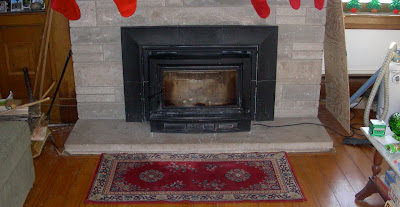 Winter often brings with it a desire to be somewhere warm, dry, and cozy. We live in a farm house that was built sometime in the second half of the 1800's and, though its 18" thick brick walls make it far from drafty, one needs a good way to heat it.
Winter often brings with it a desire to be somewhere warm, dry, and cozy. We live in a farm house that was built sometime in the second half of the 1800's and, though its 18" thick brick walls make it far from drafty, one needs a good way to heat it. something that could radiate its heat without use of any fan, and that meant a free-standing wood stove. An added bonus was a surface we could conceivably cook on, heat water on, warm socks on, etc.
something that could radiate its heat without use of any fan, and that meant a free-standing wood stove. An added bonus was a surface we could conceivably cook on, heat water on, warm socks on, etc. Because it sticks out further than the insert we needed more insulative material, so we got a piece of limestone (set on two pieces of Mycor) to match the existing hearth. So here is our beautiful new stove, the Hearthstone Heritage (my, aren't we refined?). It is a hit with the cat, the laundry, and the rest of us, and we all look forward to figuring out how to maximize its performance and charm.
Because it sticks out further than the insert we needed more insulative material, so we got a piece of limestone (set on two pieces of Mycor) to match the existing hearth. So here is our beautiful new stove, the Hearthstone Heritage (my, aren't we refined?). It is a hit with the cat, the laundry, and the rest of us, and we all look forward to figuring out how to maximize its performance and charm.

